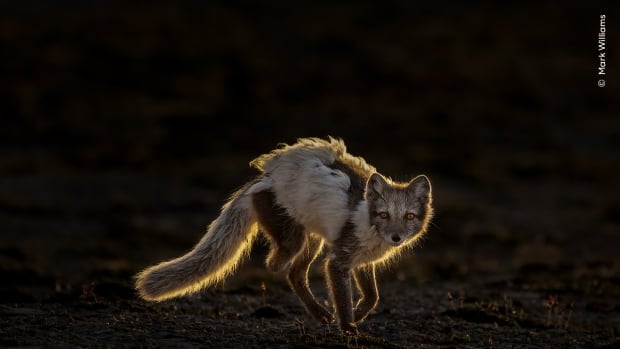Three photos from two Canadian photographers are part of the 2023 Wildlife Photographer of the Year exhibition, whose winners were announced Tuesday night.
Mark Williams, a photographer based in Jordan River, B.C., was highly commended in the animal portraits category for photos of an Arctic fox backlit by the sun and a dramatic drone shot of five belugas surfacing among fragments of sea ice, both captured in Nunavut. Garth Lenz of Victoria was highly commended in the photojournalism category for an aerial, early morning shot of the biggest open excavation on Earth, the massive Bingham Canyon copper mine in Utah.
Grand prize winners
The winners of the annual competition were announced at a ceremony in London. Wildlife Photographer of the Year is developed and produced by the Natural History Museum, London.
The grand prize went to Laurent Ballesta of France for an underwater portrait of a shiny, gold horseshoe crab at Pangatalan Island in the Philippines accompanied by three young golden travellie fish. Ballesta previously won the grand prize in 2021, and is only the second photographer to win twice in the competition’s 59-year history.
The young wildlife photographer of the year prize went to 17-year-old Carmel Bechler of Israel for a photo of barn owls in an abandoned roadside building, behind light trails from passing traffic.
In all, 100 photographs were chosen in 19 categories among 49,957 entries from 95 countries to appear in the exhibition.

The Canadian photos
Williams captured his two photos in the summer of 2022 while working as a guide at a lodge called Arctic Watch Wilderness Lodge on Somerset Island, which in the summer hosts tourists, researchers studying things like muskox populations and climate change impacts, and, sometimes, cinematographers.
He said he’s excited to share his photos of the region, since not many people get a chance to go up there.
“The beluga one is certainly one of my favourites,” he said from London on Wednesday, where he attended the awards ceremony. But he was surprised that it was chosen by the international panel of judges. “That one is quite arty and out there in my mind.”

The fox photo represented a “rare encounter” he said. He was at a camp on the side of the river around midnight, about to go to bed, when he spotted some movement in the distance that he couldn’t identify with binoculars. He went to have a closer look, and managed to capture an Arctic fox with a ragged blend of winter and summer coats haloed by sunlight. On closer inspection, he realized that it had only three legs. “It comes across as tenacious.”
Williams hopes the photos help people relate to the Arctic species impacted by climate change. He noted that many may question whether small actions they take to slow climate change make a difference. “It does make a difference,” he said. “I hope that my imagery speaks to that.”

William’s photos of the isolated wilderness contrast sharply with Lenz’s image of a giant, open pit mine.
“It’s part of my bigger project on what the Anthropocene looks like,” said Lenz, referring to the proposed geological epoch marked by humans’ influence on the Earth. Lenz’s photos of Alberta oilsands mines have appeared in two previous Wildlife Photographer of the Year exhibitions.
This year’s image was taken in 2017, when he opened an exhibition in Salt Lake City, Utah, and hired a plane to photograph the mine. The ride itself was a reminder of the impact on the landscape — thermals rising up from the massive pit cause severe turbulence. “So we were bouncing around a lot in the air,” Lenz recalled. “My head kept hitting the top of the frame of the window, which of course was open as we smacked around.”
Still, he was determined to capture images of the mine.
“I’m really trying to tell the story of our treatment of the planet,” he said. “We have become so disconnected from the environment that we take everything from — that we allow this devastation to actually occur virtually under our noses… it’s a societal problem that we don’t really see our fate as being [as] closely tied to the health of the planet as it actually is.”
Where to see the exhibition
The touring exhibition opens Friday at the Natural History Museum in London.
It makes its North American debut at the Royal Ontario Museum in Toronto on Nov. 25, It will open at the Royal B.C. Museum in Victoria on March 1, 2024.


